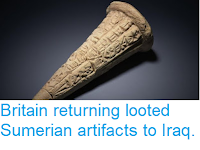The Bronze Age Harappan civilizartion dominated a huge area of what is now Pakistan and northwest India between 3300 and 1700 BC, with roots going back as far as 5500 in the Ghaggar Basin. Despite its longevity and the huge area it covered, the Harappan civilization is much less well understood than the contemporary civilisations of Egypt and Mesopotania, at least in part because its written language has never been deciphered. This has led to considerable speculation about the nature of Harappan society, with some experts arguing that the Harappan cities show clear evidence of central planning, which implies that the civilisation was essentially imperial in nature, whilst others note that the absence of any extensive military structures suggests that the society may have been more egalitarian in nature, arising from large numbers of people working together out of common purpose (though this is at odds with the clear differentiation of residential areas seen in the cities). One curious phenomenon that has been observed at many Harappan excavation sites is a high prevalence of head injuries in burials, though the cause of these is uncertain.
In a paper published in the Journal of Archaeological Science: Reports on 16 November 2018, Hyejin Lee of the Lab of Bioanthropology, Paleopathology and History of Diseases at the Seoul National University College of Medicine, and the Ministry of National Defense Agency of KIA Recovery & Identification, Pranjali Waghmare of the Department of Archaeology at Deccan College, Yongjun Kim and Jong Ha Hong, also of the Lab of Bioanthropology, Paleopathology and History of Diseases at the Seoul National University College of Medicine, Yogesh Yadav and Nilesh Jadhav, aslo of the Department of Archaeology at Deccan College, Dong Hoon Shin, again of the Lab of Bioanthropology, Paleopathology and History of Diseases at the Seoul National University College of Medicine, and Vasant Shinde, again of the Department of Archaeology at Deccan College, describe a skull showing evidence of traumatic head injury from a Harappan cemetery at Rakhigarhi in Haryana State, India, and discuss the implications of this.
Rakhigarhi was one of the largest cities of the Harappan civilisation, and is located about 150 km to the northwest of the modern city of New Dehli. The city's cemetery has produced numerous Human remains, as well as extensive red-ware pottery, something typical of Harappan sites, and has been dated to between 2616 and 2273 years BC. Most of the bodies in the cemetery are interred with a north-south alignment, with their heads to the north.
The skull in this study comes from one of ten individuals excavated from two trenches dug by archaeologists from Deccan College and the Institute of Forensic Science at Seoul National University in 2016. These include seven primary burials, in which the skeleton is more-or-less intact, plus three secondary burials (i.e. reburials) of partial skeletons; in all cases the skull is present. The sample includes two children (under 14 years) of indeterminate sex, two young adults (21-35 years in age), two of which were male and one female, and a middle aged (36-50 years old) woman, the subject of this study, and four adult specimens of indeterminate age, two of which were probably male and two of which were of uncertain sex (these four less well preserved skeletons comprise all three reburials, plus the least well preserved primary burial).
The middle aged female skull is the only skeleton in the group in which any injury could be confidently detected. The skull is well preserved, with only minimal post-mortem damage, and is confidently considered to be female on the basis of its morphology. The skull has a depression fracture on the left frontal part of the cranium, apparently caused by a blow with a round-tipped object, this appears to have completely healed after the injury, and is therefore not thought to have been the cause of death.
The cranium of BR12. Note depression fracture (indicated by arrow) at the left frontal part of cranium. Lee et al. (2019).
The precise cause of injuries is generally impossible to determine, but studies of modern injuries have found that, on the balance of probability, skull injuries below the hat brim line are more likely to be the result of accidents, and skull injuries above the hat brim line are more likely to be the result of interpersonal violence. The injury to the Rakhigarhi skull, like many injuries seen in Harappan skulls, is clearly above the hat brim line, and is therefore thought likely to have been caused by a violent blow delivered by another Human with some sort of weapon. Lee et al. suggest that this high instance of injuries apparently caused by deliberate violence is evidence of systematic violence within Harappan society, and that therefore that society was not as peaceful and egalitarian as has sometimes been suggested.
See also...
Follow Sciency Thoughts on Facebook.







